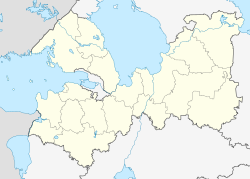Gostilizy
| Village
Gostilizy
Гостилицы
|
||||||||||||||||||||||||||
|
||||||||||||||||||||||||||
|
||||||||||||||||||||||||||
Gostilizy ( Russian Гости́лицы ) is a village (derevnja) in Leningrad Oblast in Russia , 25 km from Peterhof and 56 km from Saint Petersburg . It has 3728 inhabitants (as of October 14, 2010).
history
The first written mention of the village comes from the documents of the Novgorod Republic of the 15th century. The former estate, which is now partially preserved, was built at the beginning of the 18th century and passed into the possession of Prince Razumovsky in the 1740s . In 1764 a church of the Swjataja Troiza (Russian: храм во имя Святой Троицы , in German Trinity Church) was built there. The property remained in the possession of the Razumovsky family until 1824. In addition to the manor house, the church and service buildings, it included a spacious park with pavilions, orangeries and three cavalry corps. The so-called tea pavilion, built in the mid-18th century, is attributed to the renowned Italian-Russian architect Bartolomeo Francesco Rastrelli .
In 1825 the complex became the property of AM Potjomkin (Colonel Alexander Michailowitsch Potjomkin, married to Tatjana Golitzyna) and was rebuilt several times during the 19th century. BA Golitzyna inherited the estate in 1872 and sold it to FE von Wrangel in 1885. In 1889 Carl Heinrich von Siemens , brother of Werner von Siemens, took over the estate. After his death in 1906 his daughter, Marie von Graevenitz inherited the estate and castle. After the October Revolution in 1917, the estate was nationalized and temporarily housed a sovkhoz .
During the Second World War , the place was under the control of the German Wehrmacht from 1941 to 1944 , which had one of their bases for the siege of Leningrad nearby . During this time, many structures on the former estate were badly damaged. In the 1960s and 1970s, the place was expanded to include a few new residential areas, while the war damage to the former estate is partially visible to this day.
Population development
| year | Residents |
|---|---|
| 2002 | 3581 |
| 2010 | 3728 |
Note: census data
Buildings worth seeing
- Trinity Church
- Remains of the former manor house
- Tea house
- English country park with ponds
- War memorial with military cemetery
literature
- Bodo von Dewitz and Ludwig Scheidegger (ed.): The story of Gostilitzy. Palace and estate of Carl von Siemens near St. Petersburg . Thomas Helms Verlag Schwerin 2009. ISBN 978-3-033-01533-3
Individual evidence
- ↑ a b Itogi Vserossijskoj perepisi naselenija 2010 goda. Tom 1. Čislennostʹ i razmeščenie naselenija (Results of the All-Russian Census 2010. Volume 1. Number and distribution of the population). Tables 5 , pp. 12-209; 11 , pp. 312–979 (download from the website of the Federal Service for State Statistics of the Russian Federation)

